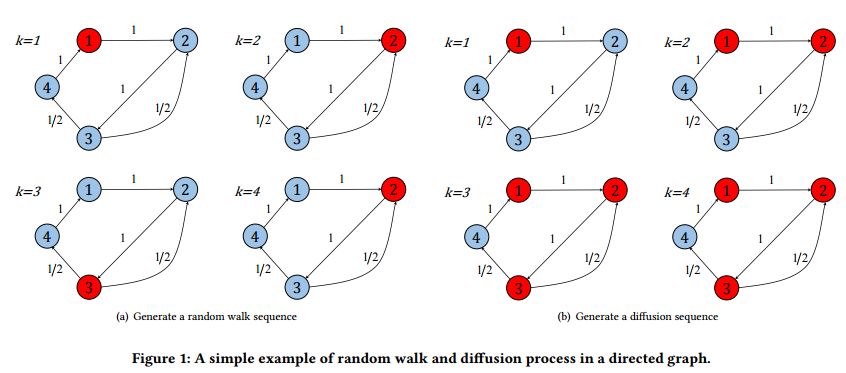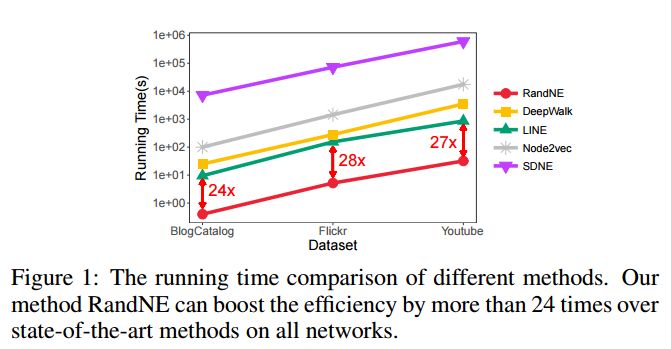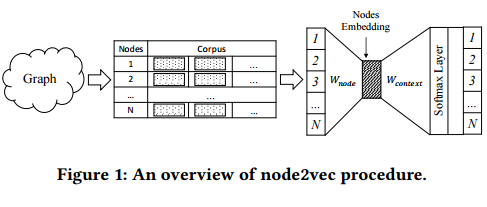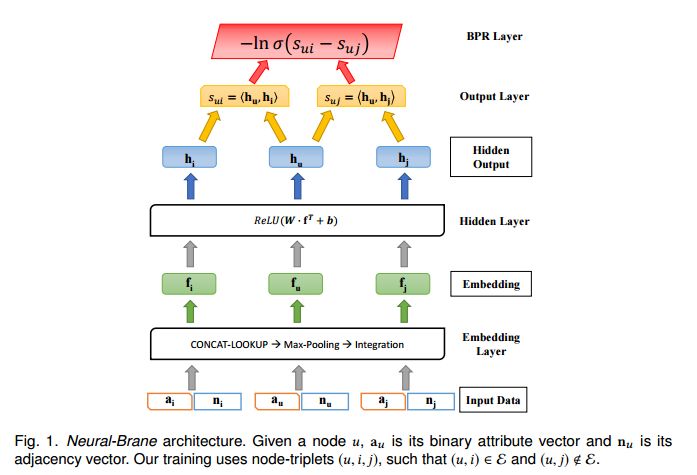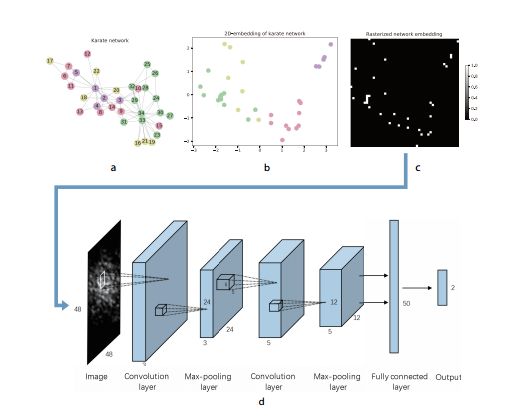【论文推荐】最新六篇网络节点表示相关论文—传播网络嵌入、十亿级网络节点表示、综述、属性感知、贝叶斯个性化排序、复杂网络分类
【导读】专知内容组整理了最近六篇网络节点表示(Network Embedding)相关文章,为大家进行介绍,欢迎查看!
1.Diffusion Based Network Embedding(基于传播的网络嵌入)
作者:Yong Shi,Minglong Lei,Peng Zhang,Lingfeng Niu
机构:University of Chinese Academy of Sciences
摘要:In network embedding, random walks play a fundamental role in preserving network structures. However, random walk based embedding methods have two limitations. First, random walk methods are fragile when the sampling frequency or the number of node sequences changes. Second, in disequilibrium networks such as highly biases networks, random walk methods often perform poorly due to the lack of global network information. In order to solve the limitations, we propose in this paper a network diffusion based embedding method. To solve the first limitation, our method employs a diffusion driven process to capture both depth information and breadth information. The time dimension is also attached to node sequences that can strengthen information preserving. To solve the second limitation, our method uses the network inference technique based on cascades to capture the global network information. To verify the performance, we conduct experiments on node classification tasks using the learned representations. Results show that compared with random walk based methods, diffusion based models are more robust when samplings under each node is rare. We also conduct experiments on a highly imbalanced network. Results shows that the proposed model are more robust under the biased network structure.
期刊:arXiv, 2018年5月11日
网址:
http://www.zhuanzhi.ai/document/f0c84ab3dbb1e313f8d4aba213566ca8
2.Billion-scale Network Embedding with Iterative Random Projection(基于迭代随机映射的十亿级网络节点表示)
作者:Ziwei Zhang,Peng Cui,Haoyang Li,Xiao Wang,Wenwu Zhu
机构:Tsinghua University
摘要:Network embedding has attracted considerable research attention recently. However, the existing methods are incapable of handling billion-scale networks, because they are computationally expensive and, at the same time, difficult to be accelerated by distributed computing schemes. To address these problems, we propose RandNE, a novel and simple billion-scale network embedding method. Specifically, we propose a Gaussian random projection approach to map the network into a low-dimensional embedding space while preserving the high-order proximities between nodes. To reduce the time complexity, we design an iterative projection procedure to avoid the explicit calculation of the high-order proximities. Theoretical analysis shows that our method is extremely efficient, and friendly to distributed computing schemes without any communication cost in the calculation. We demonstrate the efficacy of RandNE over state-of-the-art methods in network reconstruction and link prediction tasks on multiple datasets with different scales, ranging from thousands to billions of nodes and edges.
期刊:arXiv, 2018年5月7日
网址:
http://www.zhuanzhi.ai/document/a6bdbe1980b321741a363895236d5737
3.Social Network Fusion and Mining: A Survey(社交网络融合与挖掘综述)
作者:Jiawei Zhang
机构:Florida State University
摘要:Looking from a global perspective, the landscape of online social networks is highly fragmented. A large number of online social networks have appeared, which can provide users with various types of services. Generally, the information available in these online social networks is of diverse categories, which can be represented as heterogeneous social networks (HSN) formally. Meanwhile, in such an age of online social media, users usually participate in multiple online social networks simultaneously to enjoy more social networks services, who can act as bridges connecting different networks together. So multiple HSNs not only represent information in single network, but also fuse information from multiple networks. Formally, the online social networks sharing common users are named as the aligned social networks, and these shared users who act like anchors aligning the networks are called the anchor users. The heterogeneous information generated by users' social activities in the multiple aligned social networks provides social network practitioners and researchers with the opportunities to study individual user's social behaviors across multiple social platforms simultaneously. This paper presents a comprehensive survey about the latest research works on multiple aligned HSNs studies based on the broad learning setting, which covers 5 major research tasks, i.e., network alignment, link prediction, community detection, information diffusion and network embedding respectively.
期刊:arXiv, 2018年5月2日
网址:
http://www.zhuanzhi.ai/document/a792e35dcd00a75ea004c5008e4db80a
4.Scalable attribute-aware network embedding with locality(可扩展属性感知的局部网络嵌入)
作者:Weiyi Liu,Zhining Liu,Toyotaro Suzumura,Guangmin Hu
机构:University of Electronic Science and Technology of China,University of Electronic Science and Technology of China
摘要:Adding attributes for nodes to network embedding helps to improve the ability of the learned joint representation to depict features from topology and attributes simultaneously. Recent research on the joint embedding has exhibited a promising performance on a variety of tasks by jointly embedding the two spaces. However, due to the indispensable requirement of globality based information, present approaches contain a flaw of in-scalability. Here we propose \emph{SANE}, a scalable attribute-aware network embedding algorithm with locality, to learn the joint representation from topology and attributes. By enforcing the alignment of a local linear relationship between each node and its K-nearest neighbors in topology and attribute space, the joint embedding representations are more informative comparing with a single representation from topology or attributes alone. And we argue that the locality in \emph{SANE} is the key to learning the joint representation at scale. By using several real-world networks from diverse domains, We demonstrate the efficacy of \emph{SANE} in performance and scalability aspect. Overall, for performance on label classification, SANE successfully reaches up to the highest F1-score on most datasets, and even closer to the baseline method that needs label information as extra inputs, compared with other state-of-the-art joint representation algorithms. What's more, \emph{SANE} has an up to 71.4\% performance gain compared with the single topology-based algorithm. For scalability, we have demonstrated the linearly time complexity of \emph{SANE}. In addition, we intuitively observe that when the network size scales to 100,000 nodes, the "learning joint embedding" step of \emph{SANE} only takes $\approx10$ seconds.
期刊:arXiv, 2018年4月30日
网址:
http://www.zhuanzhi.ai/document/fa3c86dcab1344ae37a2bc2fde8630ea
5.Neural-Brane: Neural Bayesian Personalized Ranking for Attributed Network Embedding(Neural-Brane: 神经贝叶斯个性化排序的属性网络嵌入)
作者:Vachik S. Dave,Baichuan Zhang,Pin-Yu Chen,Mohammad Al Hasan
机构:Indiana University Purdue University
摘要:Network embedding methodologies, which learn a distributed vector representation for each vertex in a network, have attracted considerable interest in recent years. Existing works have demonstrated that vertex representation learned through an embedding method provides superior performance in many real-world applications, such as node classification, link prediction, and community detection. However, most of the existing methods for network embedding only utilize topological information of a vertex, ignoring a rich set of nodal attributes (such as, user profiles of an online social network, or textual contents of a citation network), which is abundant in all real-life networks. A joint network embedding that takes into account both attributional and relational information entails a complete network information and could further enrich the learned vector representations. In this work, we present Neural-Brane, a novel Neural Bayesian Personalized Ranking based Attributed Network Embedding. For a given network, Neural-Brane extracts latent feature representation of its vertices using a designed neural network model that unifies network topological information and nodal attributes; Besides, it utilizes Bayesian personalized ranking objective, which exploits the proximity ordering between a similar node-pair and a dissimilar node-pair. We evaluate the quality of vertex embedding produced by Neural-Brane by solving the node classification and clustering tasks on four real-world datasets. Experimental results demonstrate the superiority of our proposed method over the state-of-the-art existing methods.
期刊:arXiv, 2018年4月24日
网址:
http://www.zhuanzhi.ai/document/5107f929ce0ad689dae288764d7dd260
6.Complex Network Classification with Convolutional Neural Network(基于卷积神经网络的复杂网络分类)
作者:Ruyue Xin,Jiang Zhang,Yitong Shao
机构:Beijing Normal University
摘要:Classifying large scale networks into several categories and distinguishing them according to their fine structures is of great importance with several applications in real life. However, most studies of complex networks focus on properties of a single network but seldom on classification, clustering, and comparison between different networks, in which the network is treated as a whole. Due to the non-Euclidean properties of the data, conventional methods can hardly be applied on networks directly. In this paper, we propose a novel framework of complex network classifier (CNC) by integrating network embedding and convolutional neural network to tackle the problem of network classification. By training the classifiers on synthetic complex network data and real international trade network data, we show CNC can not only classify networks in a high accuracy and robustness, it can also extract the features of the networks automatically.
期刊:arXiv, 2018年4月8日
网址:
http://www.zhuanzhi.ai/document/d7aaf712bb2ce52a48a1c5d49b31523c
-END-
专 · 知
人工智能领域主题知识资料查看与加入专知人工智能服务群:
【专知AI服务计划】专知AI知识技术服务会员群加入与人工智能领域26个主题知识资料全集获取
[点击上面图片加入会员]
请PC登录www.zhuanzhi.ai或者点击阅读原文,注册登录专知,获取更多AI知识资料!
请加专知小助手微信(扫一扫如下二维码添加),加入专知主题群(请备注主题类型:AI、NLP、CV、 KG等)交流~
请关注专知公众号,获取人工智能的专业知识!
点击“阅读原文”,使用专知
